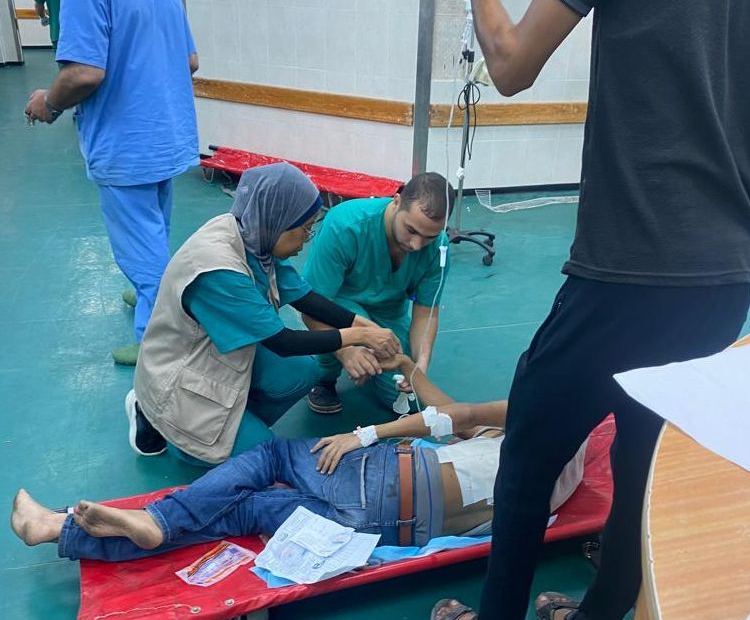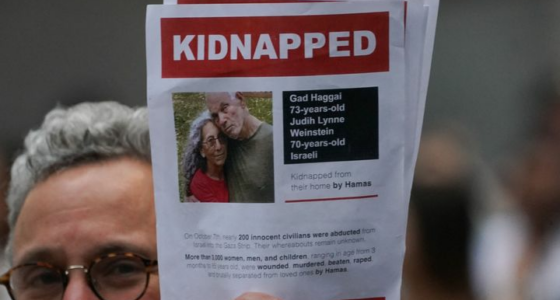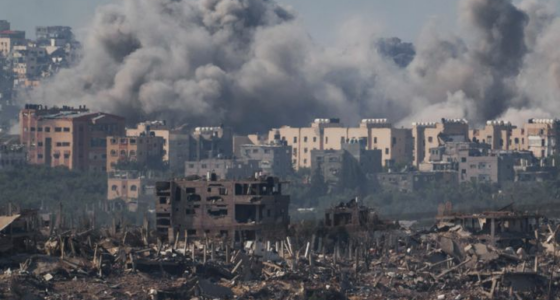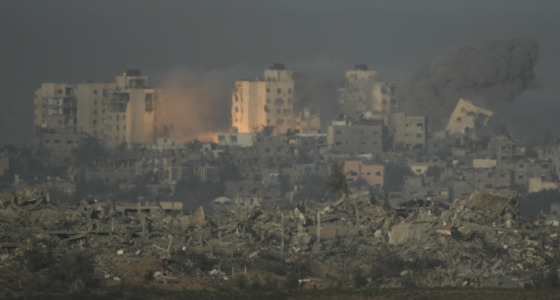Rajaa Musleh quietly sat on the fifth floor of downtown Chicago’s Marriott hotel, where the medical aid group she works for, MedGlobal, was holding a conference filled with panelists and attendees. Recalling her escape from Gaza less than a year ago, the Palestinian nurse began to fight back tears and the urge to dissociate.
After the Israeli military bombed her house in Gaza City, Musleh sheltered at Al-Shifa Hospital, the territory’s largest medical complex. But despite medical facilities being so-called deconflicted zones, Israeli forces trapped Musleh and thousands of others in the hospital for more than 40 days while killing patients and health care workers alike.
The hospital was nothing short of chaos. As a humanitarian worker, Musleh helped distribute medication and equipment to hospital staff. Then she would use her medical training to help patients in the operating room. The overcrowding meant patients were being treated without painkillers on the emergency room’s blood-covered floor. Musleh saw little children without heads, boys crying for her to attend to their phantom limbs and a severely burned 9-year-old girl who died while holding her hand. All the while, Israeli soldiers were abducting health care workers, Musleh recalled to HuffPost.
“I still smell the burned skin. Sometimes I use heavy perfume, to be honest with you, I use that just to cover the smell of the burn,” Musleh said. “I’m feeling the skin on my hand of this child, and I wash my hands maybe 30 times to remove [the feeling of her] skin. This is what I feel.”
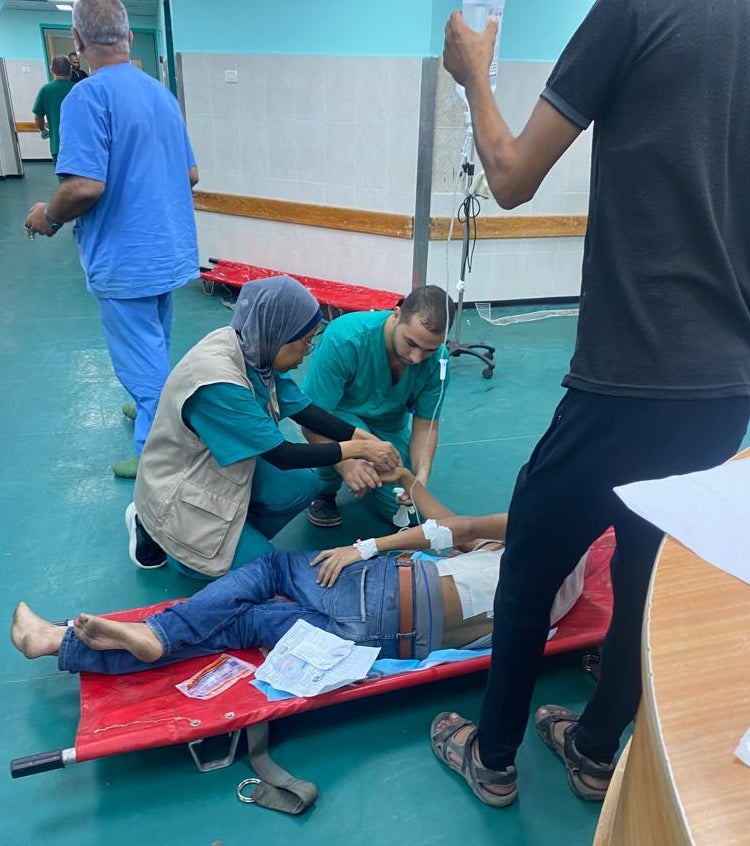
Musleh’s experience is not uncommon in Gaza, which was besieged on Oct. 7, 2023, after Hamas militants launched an attack on southern Israel that killed about 1,200 people while about 240 more were taken hostage. One year later, Israel’s ongoing military offensive ― which has now spread to the occupied West Bank, Lebanon, Syria and Yemen ― has killed about 42,000 people in the territory, according to the Gaza Ministry of Health. Medical workers estimate the number is likely closer to 119,000, and many in the international community now describe the invasion as genocide.
Israeli strikes that use U.S. weapons are largely responsible for the growing death toll. But the Israeli military has also ensured Palestinians’ eradication through a more sinister method that will continue to kill them for years to come: by collapsing Gaza’s entire health care system.
For this story, HuffPost spoke with seven medical aid workers who have served in Gaza since Oct. 7, 2023, and heard testimony from nearly a dozen more experts. The workers include trained nurses, nutritionists, surgeons and mental health professionals. HuffPost also first obtained a letter to the White House last week that had been signed by nearly 100 American health care workers who demanded an immediate arms embargo to Israel and a meeting to discuss the horrors they’ve seen in the Palestinian territory.
These medical professionals described how the health system collapse affects nearly every aspect of Gaza’s humanitarian crisis, including the overcrowded hospitals, the blocked aid, the targeting of medical workers, the mass starvation, the absence of maternal care, the spread of disease, the psychological toll and the short- and long-term effects on children.
The Chaos Inside Gaza’s Hospitals
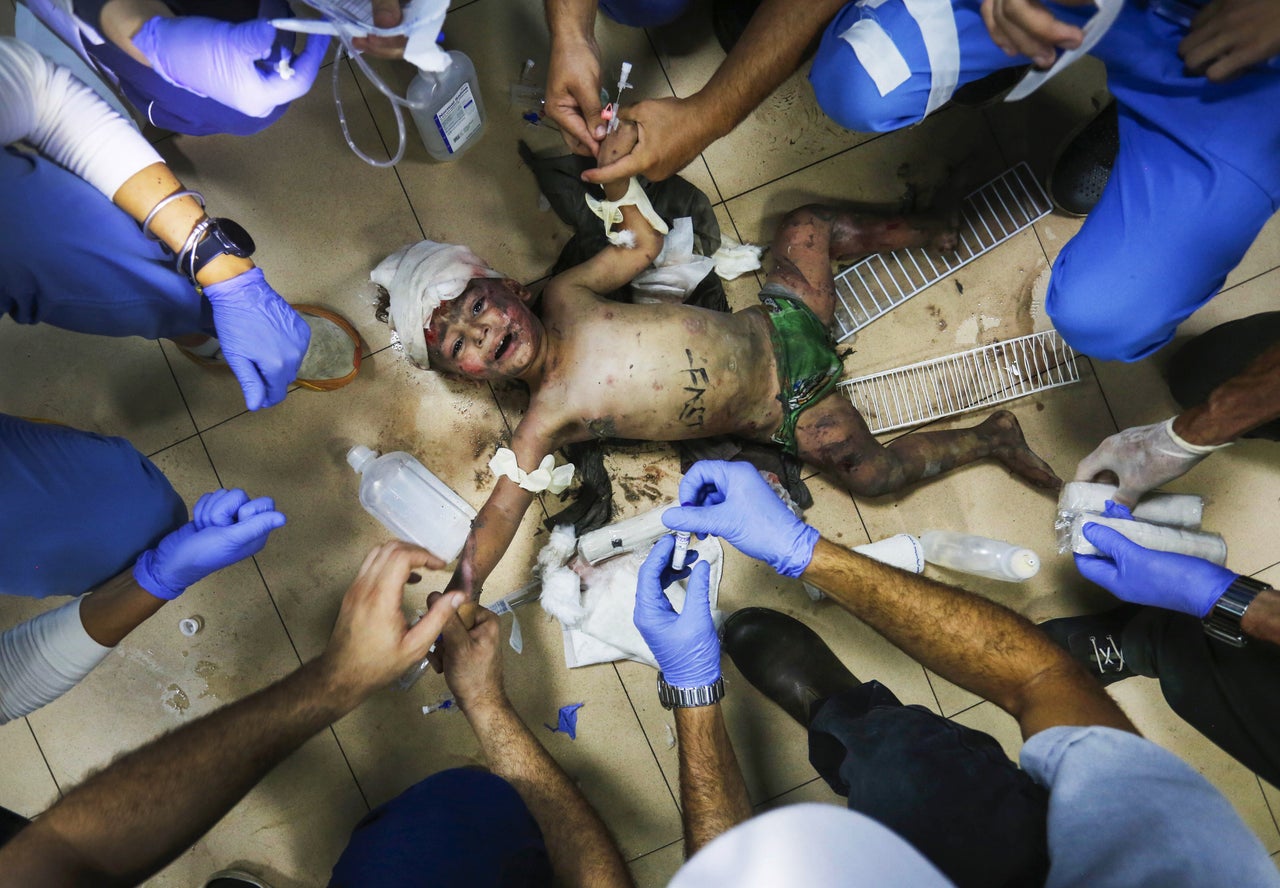
Ashraf Amra/Anadolu via Getty Images
Many of the health care workers who provided medical aid in Gaza are no strangers to operating in conflict zones, whether it be a country stricken by natural disaster or torn up by war and uprisings. Those experiences, no matter how severe, were nothing compared to Gaza, they said.
Many medical workers who spoke with HuffPost said they knew at least one colleague who had been abducted by Israeli soldiers — and that those who returned to Gaza alive had experienced violence at the hands of the soldiers.
“It was like a post-apocalyptic movie,” said Dr. John Kahler, MedGlobal’s co-founder and a retired pediatrician who’s provided medical aid in conflict zones for decades. Kahler has visited Gaza twice since Israel launched its current offensive ― once in January and again in March, both in Rafah. The doctor tried to enter the territory in May to set up a nutrition stabilization program in northern Gaza’s Kamal Adwan Hospital but was turned away by Israeli forces.
Gaza’s population of 2.3 million ― about half of whom are children and nearly all of whom have been displaced ― has only 17 out of 36 available hospitals open, none of which are fully functioning. Israeli forces have spent the past year bombing and laying siege to the hospitals, justifying their actions by claiming Hamas militants are hiding among the Palestinian civilians, patients and health care workers.
“You felt them constantly,” Dr. Feroze Sidhwa, a surgeon who worked at European Hospital in Khan Younis, said of the bombs. “They broke some windows on the third floor of the hospital. They knocked me out of bed one day. They would knock surgical instruments off the OR table sometimes.”

Mohammed Fayq/Anadolu via Getty Images
After the raids, the Palestinian Civil Defense would find hundreds of bodies from at least seven mass graves at many of the hospitals, including Al-Shifa, where Musleh was trapped in November. Many of the bodies ― including women, children and the elderly ― showed signs indicating they were patients or health care workers who were killed execution-style, Palestinian officials said at the time.
“There were signs of the Israeli raid everywhere. You can see the mass grave from the balcony, around 200 people,” Dr. Tammy Abughnaim said of Al-Aqsa Hospital, where she volunteered in March before coming back to Gaza in the summer to help at Nasser Hospital. The emergency physician recalled how Palestinian health care workers were operating “on sheer willpower,” with some telling her they were just waiting to die.
The entire hospital campus was a camp for displaced people, including for many of the Palestinian health workers themselves, Sidhwa said. Medical workers, operating room staff and nurses lived in the hospital.
When Israeli soldiers raided the hospitals, they would often accuse Palestinian medical workers, without evidence, of working for Hamas. The medical workers HuffPost spoke to said soldiers would try to take away the dignity of their detained colleagues by stripping them of their clothes, beating them and dumping them naked on the side of a road.
A Human Rights Watch report from August described the humiliation, violence, torture and sexual abuse that medical workers faced in custody ― an accusation Israeli officials have denied. Since the offensive began, Israeli forces have taken at least 310 Palestinian health care workers, at least three of whom had died in custody. Nearly a thousand medical workers ― about 1 in 20 ― have been killed in Gaza, according to the United Nations.
The Aid Blockade: A Paradox Of Availability With No Accessibility
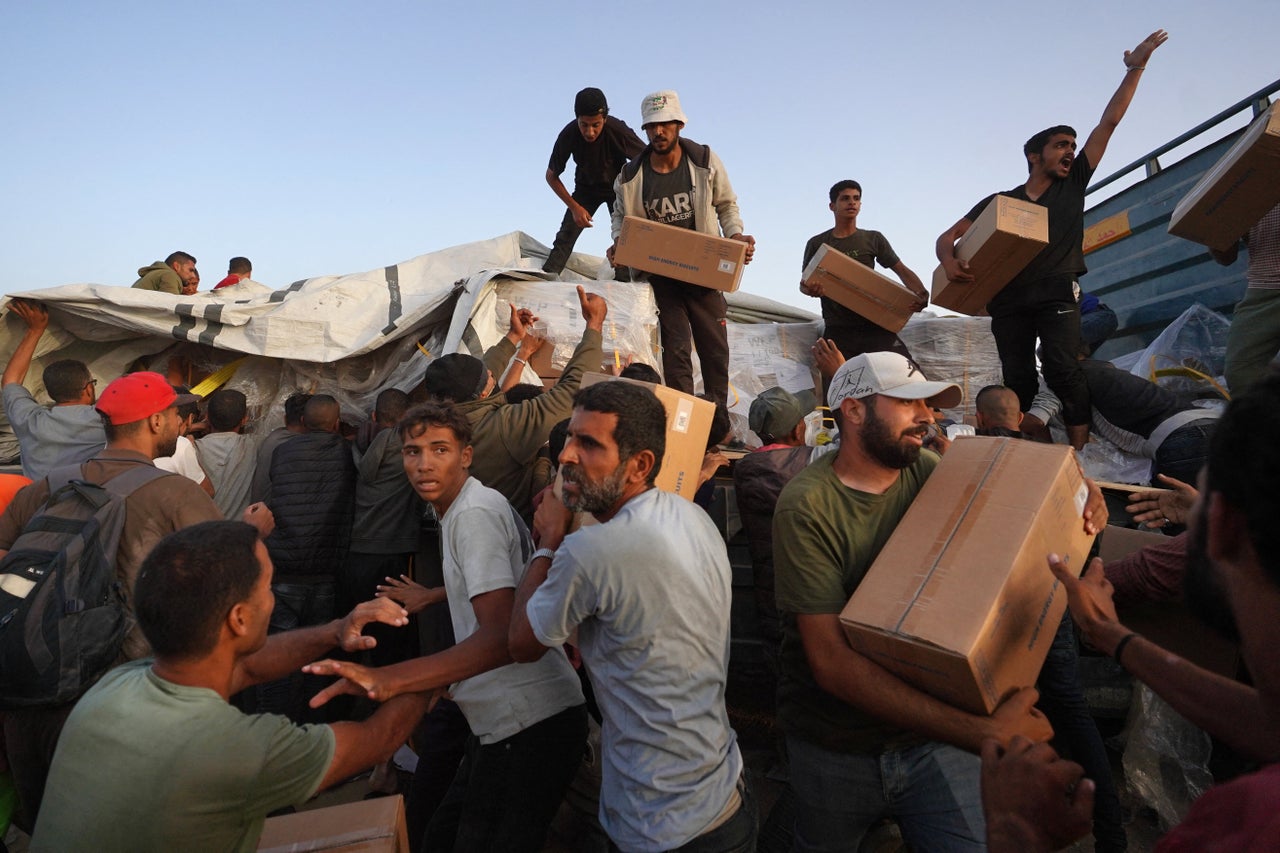
Israel has also arbitrarily blocked most aid from entering Gaza, preventing hospitals from obtaining necessary equipment and medication such as anesthesia, as well as enough fuel to run the facilities that often go without electricity. Kahler described the situation as “the paradox of aid availability but not accessibility.”
“When we were coming in from Cairo, we passed no less than 500 trucks waiting on the road to the Rafah gate, and that was in March,” he said of one of the biggest humanitarian routes, which closed in May. “So now it’s even worse. I could throw a rock from one side of the wall to the other and hit the aid; it just could not get in.”
The Israeli military has publicly claimed, particularly to its allies in the U.S., that it is allowing more assistance into Gaza, but aid workers say otherwise.
Medical workers were permitted in the spring to bring 42 bags of relevant aid and supplies into Gaza, according to Abughnaim. In July, they were restricted to just one, making it impossible to bring with them items like tourniquets, soap and disinfectant. The extreme restriction exacerbated unsanitary hospital conditions and guaranteed infections for patients.
“It was devastating to see just how much worse it can get,” Abughnaim said, recalling insects all over the medical facilities and health care workers needing to remove maggots from intubated patients who couldn’t swat them away.
The ongoing closure of the Rafah crossing between Egypt and Gaza has been “devastating” for humanitarian work, said Dr. Thaer Ahmad, a Palestinian American emergency physician who volunteered at Nasser Hospital.
“Medical evacuations are not happening consistently, aid is not getting in at the rate that it needs to get into,” he said. “But also people are not able to move in and out of there, whether it’s humanitarian actors or Palestinians who should be going back and forth.”
Aid trucks that do enter the territory often don’t even make it to their destination due to destroyed road infrastructure and the threat of Israeli snipers and drones. The U.S.’s decision to halt funding for UNRWA ― the UN agency with the means to distribute massive amounts of aid to Palestinians ― combined with Israel’s starvation campaign has also led to a breakdown of social order when aid does arrive.
“We’re now talking a year into this, and people are starving. Well, guess what happens when people starve? They do what they have to do to get food,” Kahler said. “So you’ll see the trucks come in and you’ll see people on top of them with sticks and stuff like that. People say, ‘Oh, they can’t even trust getting aid in.’ Well, of course you can’t. If you starve a group of people, they’re going to do what they need to do when they see food.”
What Starvation Does To The Body
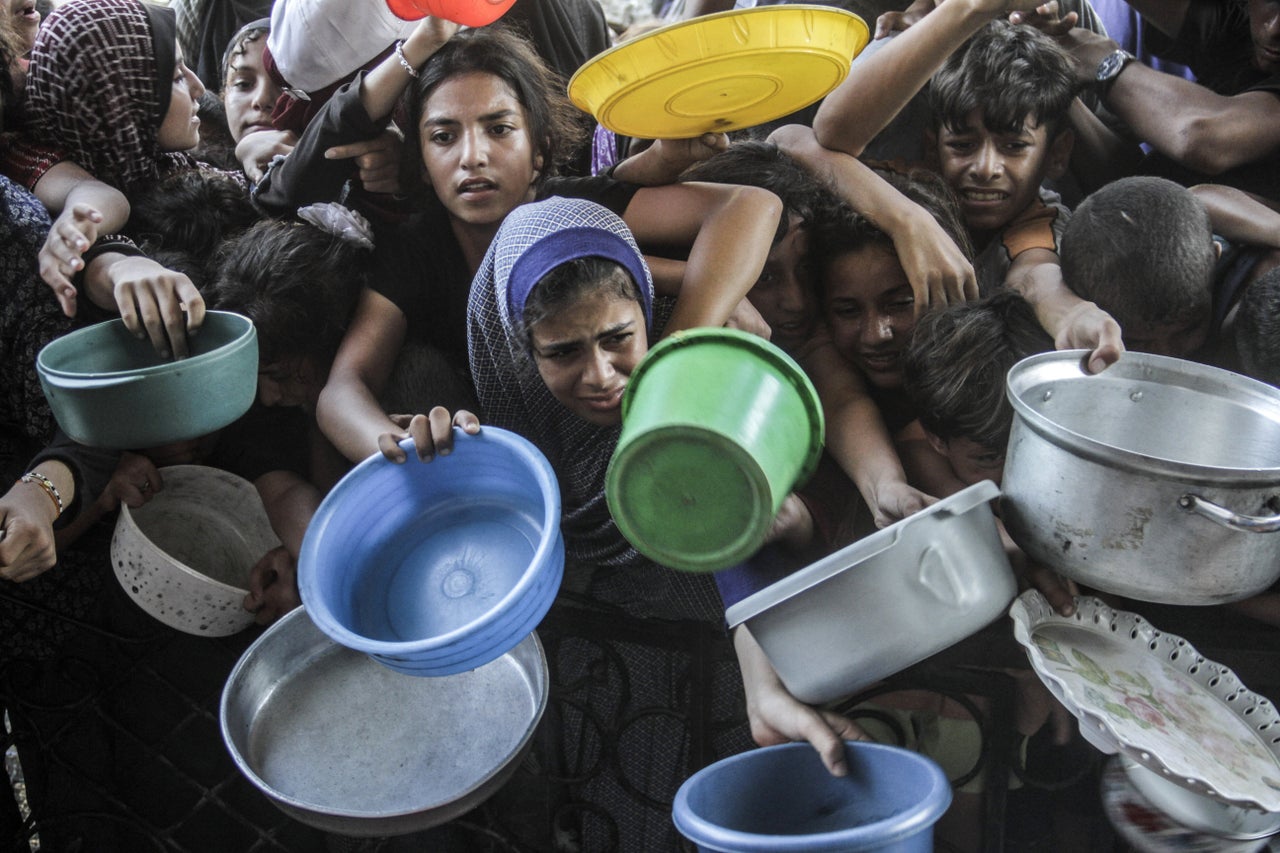
Mahmoud Issa/Anadolu via Getty Images
Israel’s offensive has created ideal conditions for a shockingly severe starvation campaign in Gaza by destroying the land and its agriculture, forcing Palestinians to fully depend on the very aid that the military still won’t allow inside the territory. Last month, the U.N. special rapporteur on the right to food accused Israel of deliberately starving people in Gaza as a way to exterminate the Palestinian population. Israel has denied the claim.
“North Gaza is still suffering from malnutrition,” nutritionist Rana Soboh said of the territory’s region, where she lives with her family.
The man-made famine first became visible in Gaza’s northern region, forcing many Palestinians to resort to eating grass, weeds and animal feed for sustenance.
“The body needs protein and multivitamins, calcium, zinc, magnesium,” she said. “If the patient doesn’t have enough protein or calcium ― you know, the bone consists of protein and calcium ― and we need this to improve muscle and improve healthy brain [function]. And here in north Gaza, there’s no sources of protein or calcium, or any multivitamins in general.”
One in five Palestinians in Gaza is facing starvation, according to the Integrated Food Security Phase Classification (IPC). The families in Gaza who are lucky enough to access food aid usually receive only flour, some canned vegetables and no protein.
Oftentimes, teens and adults will give their food to younger kids in the family, given that acute malnutrition is more fatal for children. More than 21,600 Palestinian children between 6 months and 5 years old have been diagnosed with acute malnutrition in Gaza, and at least 28 children younger than 5 have died of it, the U.N. reported last month.
“Children suffering from malnutrition are more likely to experience delays in physical and congenital development, which can negatively impact their academic performance and future opportunities,” Soboh said. “On the other hand, for adults, malnutrition can weaken the immune system and increase the risk of chronic disease, further straining the health care system.”
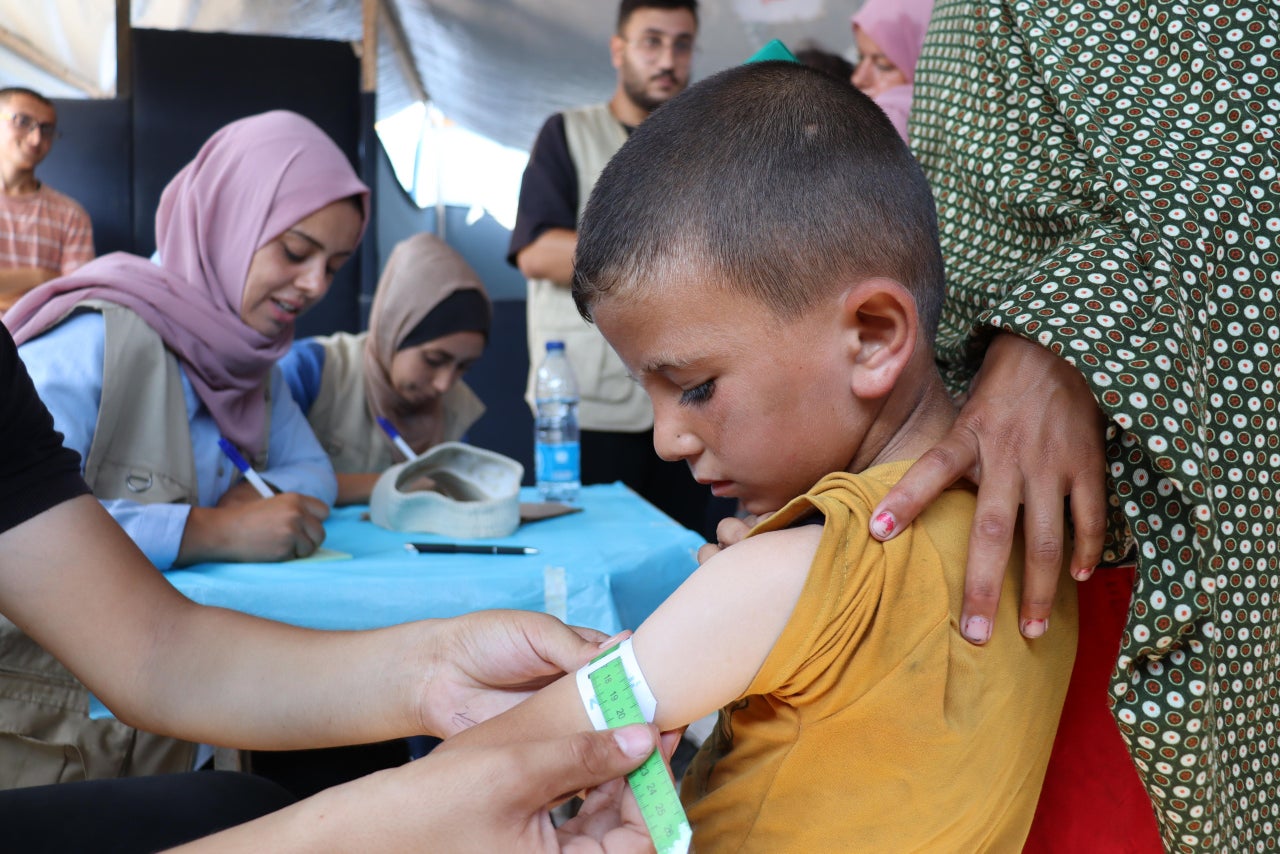
People of all ages who are experiencing malnutrition will often show visible signs of weight loss, weakness and breathlessness. As the months pass, doctors will notice that malnourished patients often have anemia, muscle wasting, water retention and a compromised immune system that makes it easier for them to get infections and harder to fight them off. Malnourished children, specifically, will experience stunted growth and the inability to focus. In severe cases, they’ll develop a distended stomach and swollen legs, as well as changes in skin pigmentation.
Kahler worked with UNICEF earlier this year to set up a nutrition stabilization site in Rafah. The process of re-feeding is dependent on just how severely someone is malnourished, he said.
“We’re now talking a year into this, and people are starving. Well, guess what happens when people starve? They do what they have to do to get food.”
– Dr. John Kahler, co-founder of MedGlobal
“It’s an inverse relationship between how sick you are and how fast you receive,” Kahler told HuffPost. Though seemingly counterintuitive, people who have been malnourished for prolonged periods of time should not eat quickly when food becomes available. Kahler says these types of patients will need to eat very slowly in order to recover.
“The other thing that happens there is the gastrointestinal system,” Kahler explained. “The lining has sloughed off for so long that it won’t digest the stuff, so they’ll just pass through.”
In Gaza, malnutrition is disproportionately affecting pregnant women and new mothers, according to medical workers in the war-torn area. Many pregnant women who are malnourished will either give birth prematurely or even lose the baby due to the lack of micronutrients, according to Soboh.
“Malnutrition led to widespread spontaneous abortions, underweight newborns and an inability of new mothers to breastfeed. This left their newborns at high risk of death given the lack of access to potable water anywhere in Gaza. Many of those infants died,” American medical workers testified in last week’s letter to the White House. “In Gaza we watched malnourished mothers feed their underweight newborns infant formula made with poisonous water.”
Sickness And Disease
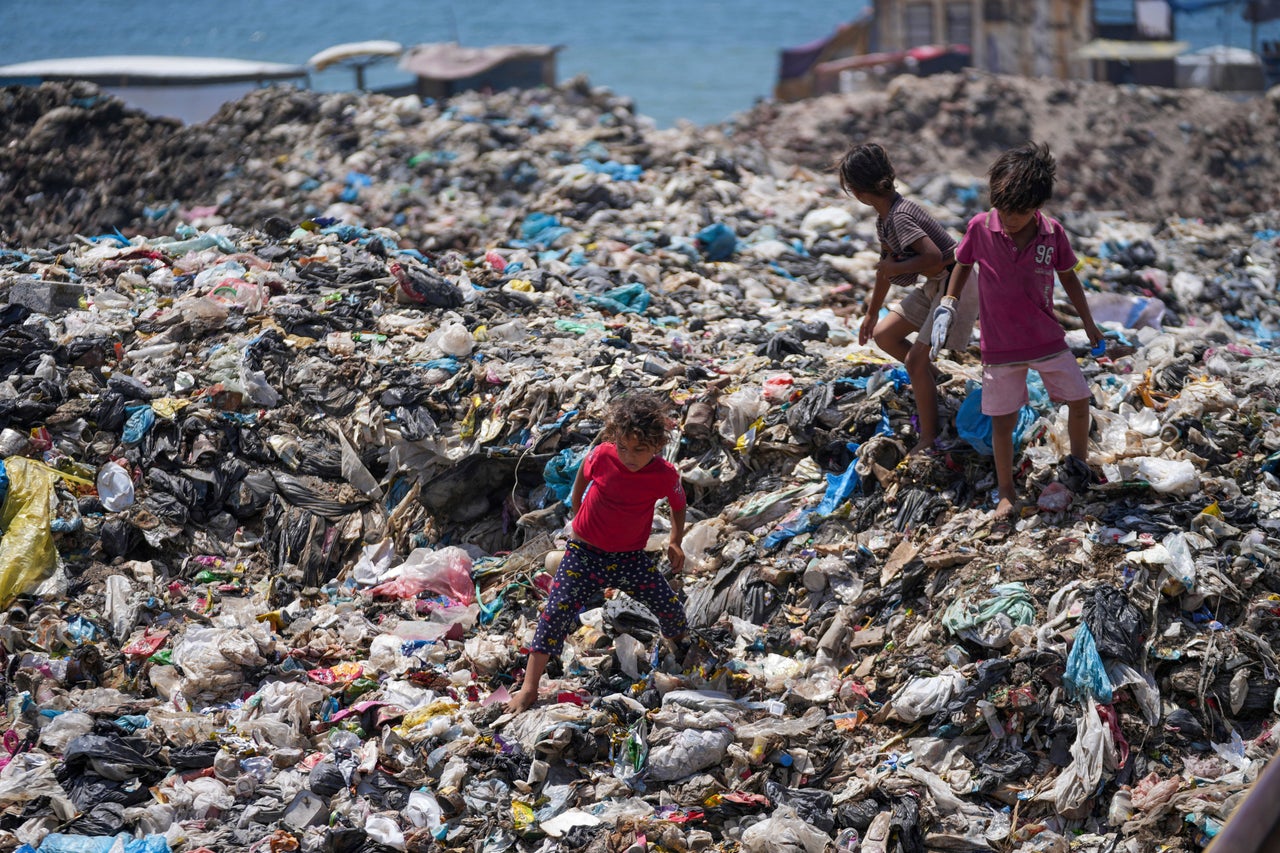
Abdel Kareem Hana via Associated Press
The spread of disease and the exacerbation of existing illnesses in Gaza is a direct result of the combination of a man-made famine, inhumane living conditions caused by displacement, the bombing of so-called safe zones and a collapsed health care system.
Israel’s offensive has destroyed 70% of Gaza’s sewage pumps and all five wastewater treatment plants while blocking external water supplies, reducing the amount of available water in the territory by 94%, according to a July report by Oxfam, a coalition of anti-poverty organizations. Palestinians now get about 1.25 gallons of water a day per person, just under a third of the recommended minimum in emergencies and the equivalent of less than a single toilet flush.
Because of the lack of water and sanitation infrastructure, 28% of Palestinians have fallen severely ill from easily preventable diseases, Oxfam said. Families without basic hygiene are living in close quarters with no running water or toilets, in tents that sit next to large piles of sewage and trash.
“I want you to put yourself in a place where you actually can smell the rot, feel the crap on your skin because you haven’t taken a real bath in six months, taste the crap that’s in the air,” Kahler said. “With all those tons of bombs, what’s in the air, let alone on the ground ― these are old buildings, there’s asbestos in the air.”
More than 995,000 Palestinians have been diagnosed with acute respiratory infections and more than 577,000 have cases of acute watery diarrhea, according to the U.N. Tens of thousands of Palestinians have also experienced jaundice, bloody stools, hepatitis A and scabies. Medical workers have scrambled to distribute vaccines in Gaza after high concentrations of poliovirus were found in the sewage, and a case of polio was detected in a 10-year-old boy this summer.
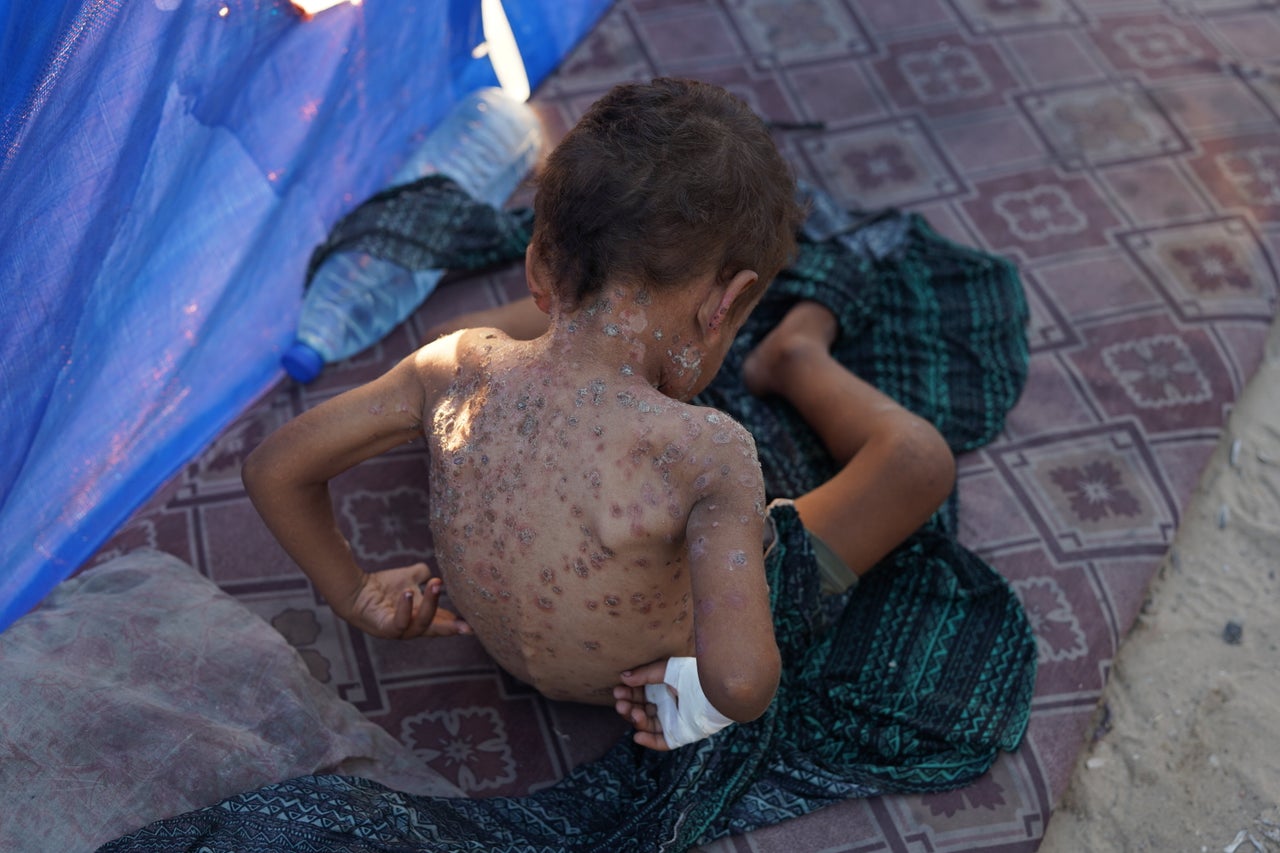
Ibrahim Nofal/Anadolu via Getty Images
“If measles comes into a camp of malnourished kids, that’s when measles is more likely to kill [part] of the population. And God forbid cholera ever gets introduced into the general population in Gaza right now,” Kahler said. “Once it’s in there, it doesn’t go away. That’s the other thing with [cholera] ― if you bring it into virgin soil, even when you stop the outbreak, it’s still there. This is why you still have recurring outbreaks in Haiti right now.”
The military offensive has also made it impossible for Palestinians with existing long-term illnesses, such as cancer or Type 1 diabetes, to get the treatment they need. Most hospitals no longer have specialized wards, and the aid blockade has prevented necessary medication from getting in, essentially turning treatment for some patients into hospice care.
“We worry that unknown thousands have already died from the lethal combination of malnutrition and disease, and that tens of thousands more will die in the coming months, especially with the onset of the winter rains in Gaza,” the medical workers said in last week’s letter. “Most of them will be young children.”
The Collective Psychological Damage
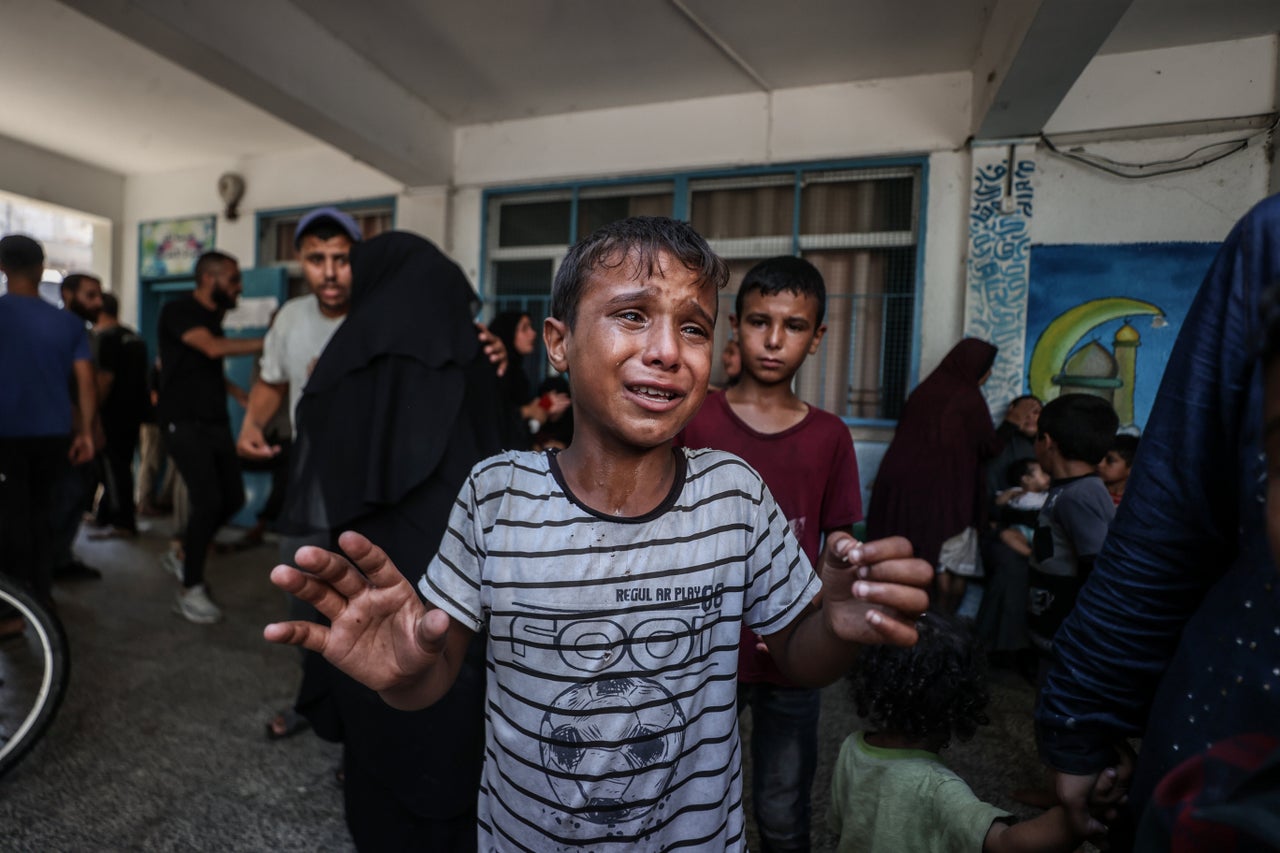
Ali Jadallah/Anadolu via Getty Images
One of the longest-term health issues that Israel’s year of attacks will have on Gaza is the extreme psychological damage facing every Palestinian, many of whom were already experiencing problems with their mental health as a result of a 17-year blockade on the territory and the generational trauma of being under occupation for 75 years.
“In this situation, in this population, resiliency is resistance. So love is resistance,” Kahler said of the Palestinian people.
Because of the aid blockade, many patients no longer have access to medications that are necessary to address psychiatric issues like schizophrenia and bipolar disorder. And all the health care workers who spoke with HuffPost concluded that every single child in Gaza has ongoing traumatic stress, manifesting in a range of behavioral and physical problems, including dissociation and mental exhaustion.
“I get children coming into the emergency department all the time saying things like, ‘I’m just tired. I’m fatigued,’” Abughnaim said. “You know, it’s not just the heat exhaustion, it’s not just the heat stroke. It’s also psychological fatigue, it’s psychological trauma. And these are things that I can’t necessarily fix with an IV and some lab work and all that.”
“We’re talking about children writing their wills.”
– Dr. Mustafa Elmasri, Gaza psychiatrist
With families constantly operating in survival mode because of the mass death and displacement, children will also show signs of shock and regression. A Gazan child’s sense of stability, which is key to maintaining good mental health, is practically nonexistent when families are being forcibly evacuated a dozen times. Compounded by malnutrition, that kind of stress can lead to bedwetting, an abnormal level of clinginess and an inability to express themselves, Kahler said.
“We’re talking about children writing their wills. They have to take care of their younger siblings and at the same time try to make a living, try to bring water, try to bring some food for the family,” said Dr. Mustafa Elmasri, a Palestinian psychiatrist in Gaza.
Ahmad recalled multiple instances in which families in the emergency room would quietly watch while he and his colleagues tried to resuscitate a loved one who would end up dying.
“By the time you’re done, you’re calling the code and basically calling time-of-death, you look up and you start to realize that the mom, the sibling, the younger brother, they were all watching all of that unfold,” he said. “They were watching this very aggressive and violent resuscitation after this violent moment. And witnessing something like that, I just don’t know how they can survive this from a mental health perspective.”
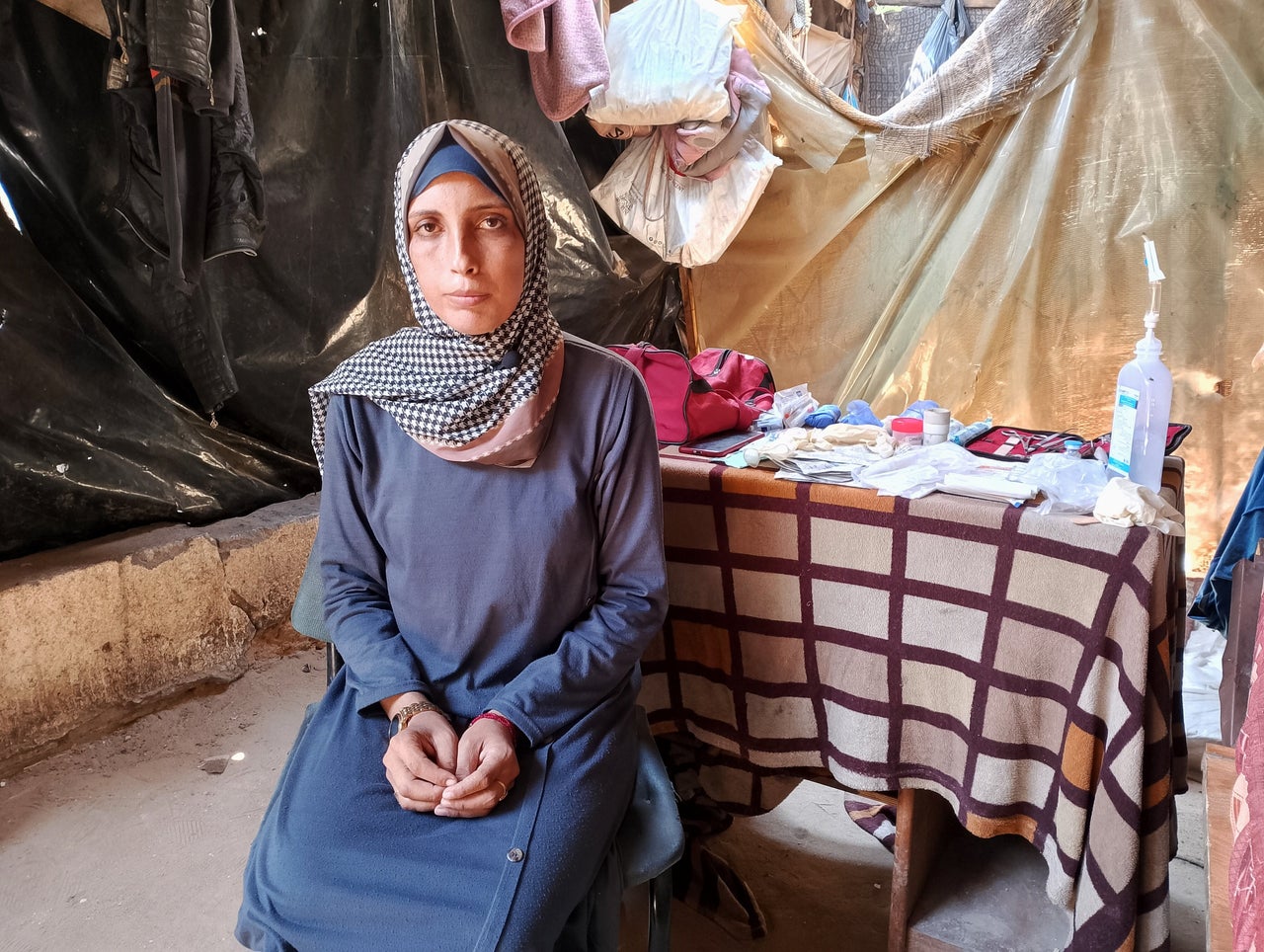
Waleed Mithqal Ishaq Musleh/Anadolu via Getty Images
The Israeli military’s siege has not just inflicted psychological damage on Palestinian civilians and patients, it has also affected the health care workers themselves, many of them Palestinian, who have been operating around the clock while absorbing an equal if not even more severe level of trauma.
“I have dreamed of these children that I deal with at the hospital, and I will never forget their sounds when they’d try to call, ‘Hi, doctor. Hi, doctor, please help me.’ And I cannot stop their pain because there is no painkiller,” Musleh tearfully recalled of her experience at Al-Shifa. To this day, she avoids sleeping more than a couple of hours out of fear of more nightmares about the dead. According to research, these types of sleep disturbances and recurring nightmares have been associated with post-traumatic stress disorder.
The medical workers said they experience insomnia, panic attacks and rage while still trying to hold on to kindness when interacting with families at the health facilities. Medical aid workers from the West, in particular, spoke of the gnawing anger, helplessness and moral distress they all felt upon leaving Gaza. The difficulty of processing those emotions is “eating me up right now,” Kahler said.
Coming back to the U.S. from her most recent Gaza trip, Abughnaim described being the closest she had ever felt to psychosis, unable to meet the impossible task of compartmentalizing all the horror she’s seen. But working with a therapist is helping her accept that her emotions are normal in the face of unending mass death.
“As humans, we are programmed to respond to atrocity in this way so that we don’t see it happen again, right? … [That] compels us to make a safer world. And so ignoring your normal response to that is not only unhealthy, it’s unproductive,” she said.
“So if I have to break down on my drive home and pull over to the side of the road and cry hysterically for half an hour, I’m doing that. And it’s not the most productive thing in the world, but I don’t know what else to do with all of the pain inside. I don’t know how to grieve 15-20,000 children.”
What Does Rebuilding Gaza’s Health Care Look Like?
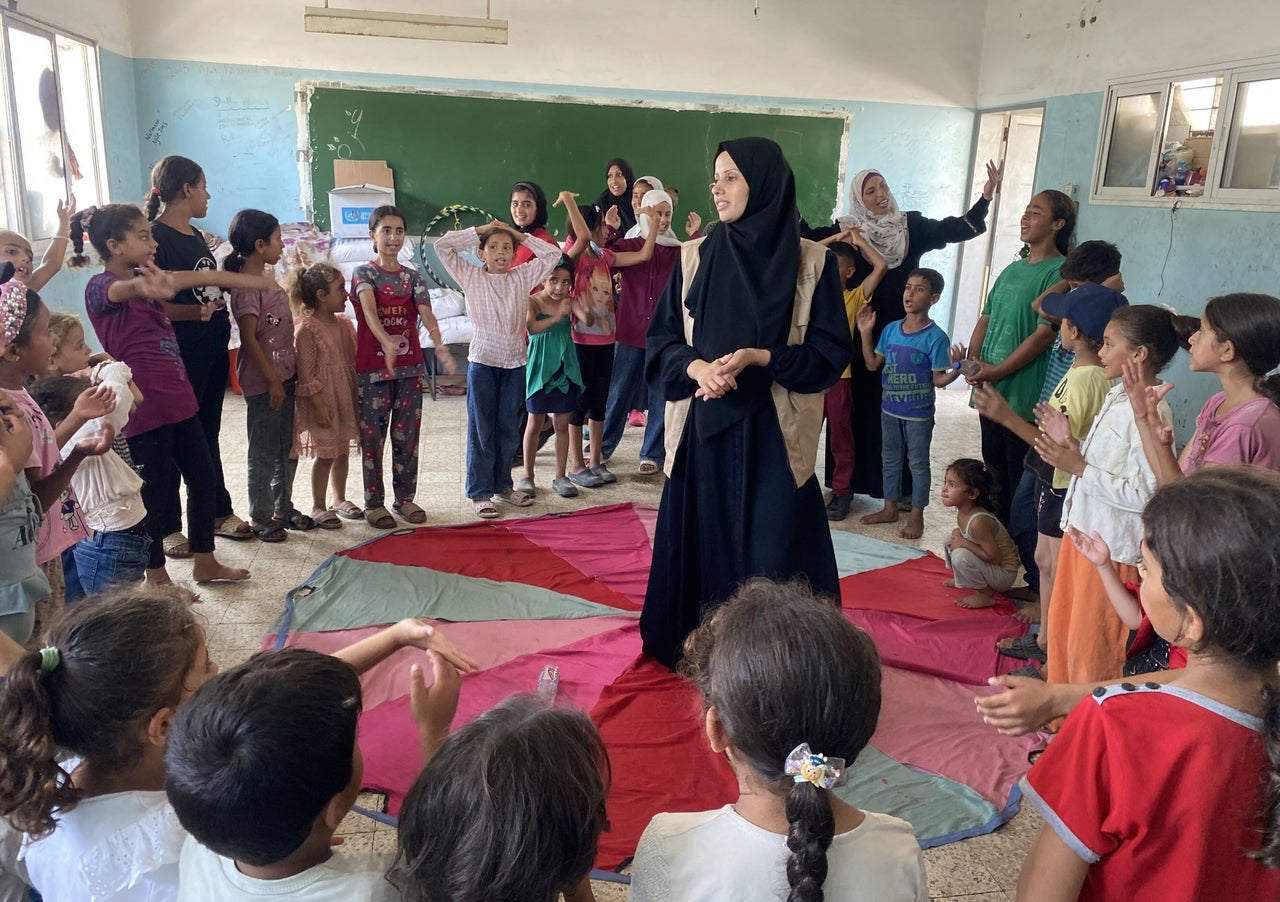
Doaa Albaz/Anadolu via Getty Images
Despite the medical industry’s expectations that medical workers stay apolitical in their work, health care professionals who served in Gaza say they refuse to do so when the system’s collapse and the aid blockade is already political. This is especially pressing for these workers at a time when the U.S., which is Israel’s biggest ally and the home country for many aid workers, continues to give Israel the green light to continue its offensive in Gaza.
“If the United States were not complicit in this, and I was not a United States citizen, it would be much easier to bear, frankly,” Abughnaim said, echoing Ahmad’s sentiment that there is no “political will” from the U.S. to actually secure a permanent cease-fire in Gaza.
A permanent cease-fire is the most obvious answer for what needs to happen to begin the rebuilding process, according to most medical workers who spoke to HuffPost. As a physician, Ahmad spoke to at least six U.S. government entities, as well as the United Nations, to argue a case for a cease-fire in Gaza. But given that there is no end in sight to the fighting, American medical aid workers are pleading for officials to reopen the Rafah humanitarian crossing and allow the free flow of aid that would be screened by an independent inspection team instead of the Israeli military.
“I think we have to acknowledge that the day after cannot look like the day before,” Ahmad said. “There was still a blockade on Gaza. There was still restrictions of goods entering. There was still a high amount of medical supplies that would be rejected by the Israeli authorities. That needs to change.”
Part of a rebuilt health care system in Gaza must include treatment for the massive number of new Palestinian amputees, more mental health support and specialized nutrition rehabilitation, he said.
“To prevent future famine, we have a range of solutions to address the root causes of food insecurity here in Gaza, such as promoting local agriculture through innovative methods like vertical farming,” Soboh said. “Also, supporting small businesses and ensuring a steady supply of essential food items through international aid and local production.”
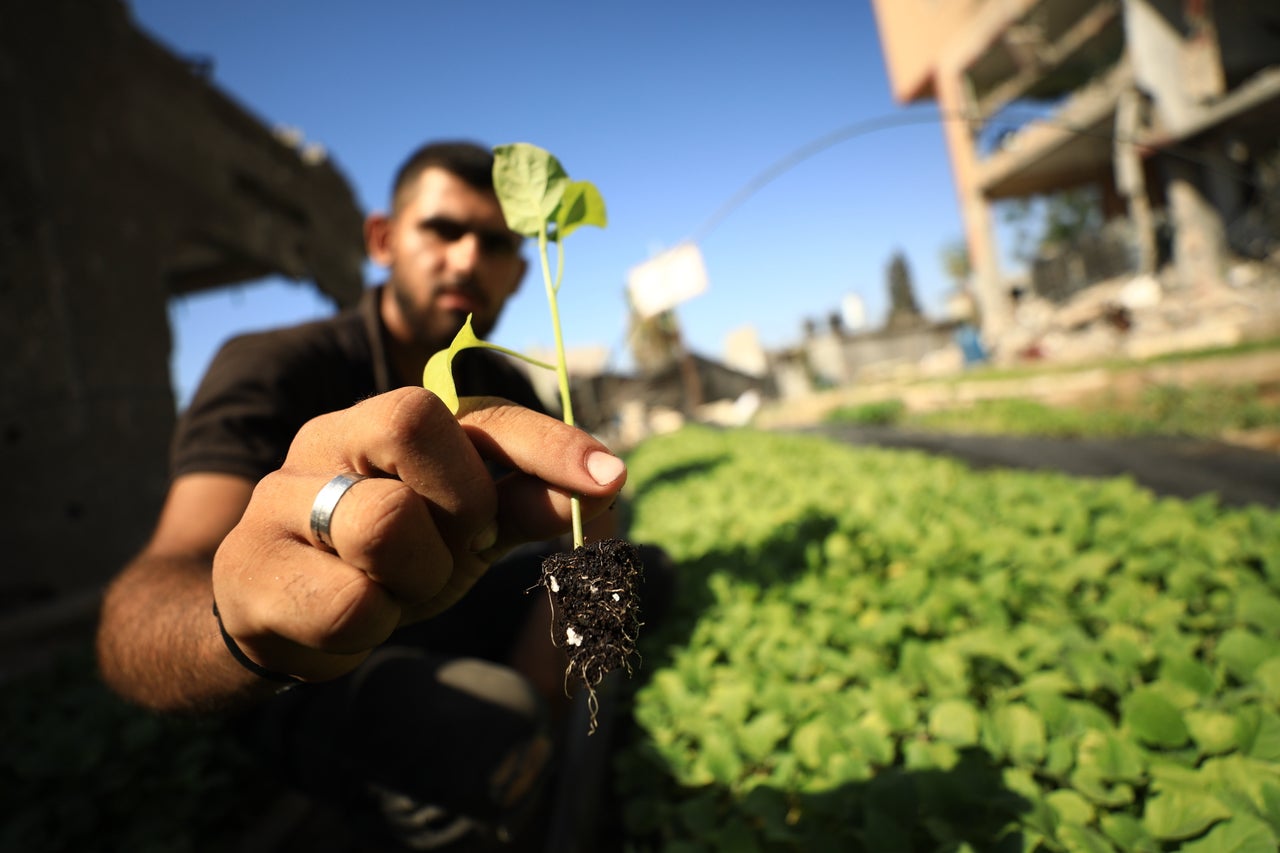
Dawoud Abo Alkas/Anadolu via Getty Images
Because the conflict has deeply affected Palestinians’ nervous systems, Dr. Nimr Ikram suggested the possibility of electroconvulsive therapy (ECT) or ketamine-assisted therapy, both of which have shown positive results for treating severe depression and mental trauma. Aid groups should also financially and educationally support Palestinian mental health workers so they can treat their own community instead of always relying on Western health care providers, he said.
A more holistic approach could involve storytelling and singing ― methods that have been used by indigenous communities to foster intergenerational healing, according to Mohsin Mohi-Ud-Din, who has been implementing community spaces for Palestinians in Gaza to practice emotional regulation. Mohi-Ud-Din has found that Palestinian medical professionals were able to reduce their stress after receiving validation from their colleagues in the hospital and that Palestinians of all ages found reprieve after doing breathing exercises and engaging in artwork.
“The ground was shaking as we were doing this,” he said of the artwork on prayer rugs, but a mother holding her 3-year-old told him, “This is the first time I do not feel the war.”
“I have no right to not be optimistic. If my colleagues in Gaza who can’t get out remain optimistic, then who the hell am I not to?”
– Dr. John Kahler
Almost none of the Western health care workers expressed optimism that Gaza’s suffering will end soon, but all of them said they draw any hope they have from the Palestinian people.
“I have no right to not be optimistic,” Kahler said. “If my colleagues in Gaza who can’t get out remain optimistic, then who the hell am I not to?”
Musleh is one of those optimistic Palestinians. In order to rebuild Gaza, the international community must see Palestinians as human beings who also have dreams and a right to live in peace, Musleh said, and that is something she said she will never stop fighting for.
“I will never, ever let down my people. I will return and support them. I will deliver care for the people, and I will create new programs and new services for the people there,” Musleh said. “Yeah, sometimes I feel up and down, but I will do my best to serve my people because they deserve it.”
“We will get up and we’ll rebuild. We will rebuild the universities, we will rebuild the hospitals, we will rebuild the health system. Yes, we will.”

